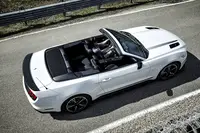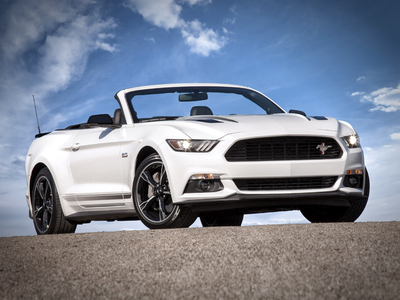2016 Ford Mustang GT Premium Convertible Review by Carey Russ +VIDEO
The Best Mustang Convertible EVER
DRIVING DOWN THE ROAD WITH CAREY RUSS
• SEE ALSO: Ford Research and Buyers Guide
 2016 Ford Mustang |
Early Fall sunshine and a convertible. What could be better? Especially since the convertible in question is a 5.0 Mustang GT.
Being Fall, of course it’s time for a triple-digit heat wave. No problem, the Mustang’s insulated top, with a clear-visibility heatable glass rear window, keeps the heat out readily, with decent visibility up, and typical Ford instant air conditioning makes the interior quickly comfortable. Add heated and cooled seats (that last being the important thing right now) and there’s little difference between the convertible and coupe. When it gets cooler, or when traveling at speed on the highway and backroads, the top quickly goes down with the twist of a latch and press of a button. Extra bonus — the top stows behind the rear seat, with no impact on trunk space. And there really is a useable amount of trunk space, 11.4 cubic feet to the coupe’s 13.5. This is not just a weekend toy. The current Mustang convertible is a practical year-round only car, unless you live far off the grid.
The convertible is available with all three of the regular production Mustang powertrains. Performance is the name of the game, and all have at least 300 horsepower. The 3.7-liter V6 is good for 300 hp and 280 lb-ft of torque. The EcoBoost 2.3-liter turbo four maxes out at 310 hp and 320 lb-ft. And the 5.0 V8is good for 435 hp and 400 lb-ft. Even more is available with the new-for-2017 Shelby GT350, but no convertible there and limited production means limited availability.
New for 2015, the current Mustang is the most impressive yet. Little was left unchanged from the previous generation. Most significantly, it’s the first to have fully-independent suspension in all production versions. That makes for significant improvements in ride and handling, and a degree of refinement unexpected in a Mustang. With no loss of character. Structural rigidity has increased, and although all body panels have been changed, it’s immediately recognizable.
The 5.0 coupe was the first new Mustang I drove, at a journalists’ track day. It was appropriately loud and rowdy-sounding, and amazingly stable and civilized pushed harder than would be reasonable on the street -- a long, long way from the flint-axe character of the long-lived Fox-platform 5.0s of the past, and even noticeably better than the previous generation's performance models.
A year ago I spent a week with and EcoBoost coupe. It had the automatic, not the stick, but with its broad torque curve that was a non-issue. Similar in weight to the V6 and with more power and torque, while lighter than the V8, it was an impressive homage to the SVO of the mid-80s. But there’s something about a V8 in a Mustang that’s right…
And the 5.0 convertible is right. It’s offered in upscale Premium trim only, and is more relaxed in demeanor than the coupe as removal of the (structural) hard top means a bit less chassis rigidity, and more weight — about 120 pounds here — in lower unibody reinforcement. Yes, there is some noticeable cowl shake on poor surfaces, but less so than with many other convertibles. With 435 horsepower potentially on tap, a few extra pounds don’t make much difference. And when driving through the forest on the scenic route, a convertible has it all over a coupe with a sunroof.
A useable back seat and trunk add to its attractiveness, and performance with the other available engines will still be more than adequate, even without the classic V8 rumble. Fuel economy has never been a reason to buy a V8 Mustang, and the 15 or so mpg I saw in around-town and short highway trip use was nothing special. I had a 200-mile roundtrip, three-quarters highway (hilly and average speed 65 plus, emphasis on plus unless you want to get in trouble in the slow lane) and one quarter 20- to 40-mph mountain roads. Average after returning from that? An honest 20 mpg. Not bad at all, all things considered. This one had the California Special package, a mainly cosmetic option group that is available in places other than California. It was a 2016 model. Don’t expect any significant changes for 2017. None needed.
APPEARANCE: The newest Mustang is muscular and toned, but without steroids. The body and grille shapes establish continuity with its predecessors, and the triple vertical taillights are the newest interpretation of a long-time Mustang styling cue. The double-edged dome on the hood is also familiar -- but all styling elements blend seamlessly and coherently. Even the projecting "aero kit" bits around the lower perimeter look right, and not like afterthought add-ons. Rear-facing turn signal indicators at the front of the hood are new for 2016 GT models. Top-up, the convertible has a similar profile to the coupe, if not quite as smooth. Top-down, it looks absolutely right, with classic long-hood, short-deck proportions. The California Special package is cosmetic, adding badging, black stripes and rear spoiler and black-trimmed alloy wheels.
 2016 Ford Mustang |
COMFORT: This is a driver’s car. The front seats are well-bolstered and offer good support and ease of access. They are both heated and cooled at Premium level, and California Special means grippy Miko® suede-like centers. It also means patterned aluminum-look dash trim and badging. The leather-trimmed steering wheel is manually-adjustable for tilt and reach, and the driver’s seat cushion is power-adjustable for height, so all drivers can find their perfect position. The steering wheel has the usual audio, cruise, phone, and information controls. The instrument panel’s double-cowl design is a Mustang tradition. Instruments are backlit and easily visible, and a useful information display sits between the speedometer and tachometer.
The Sync3 infotainment interface is much-improved over the old MyFordTouch, and controls audio, some climate, phone, and settings systems plus various add-on apps. Still, the main audio volume and tuning and climate control functions are via simple, direct knobs or buttons. The screen has pinch-to-zoom control, useful with the nav system. The glove box locks, and there is some storage in the doors and console. Top-up, it’s nearly as quiet inside as in the coupe. Top-down, windows-up there is little buffeting, even at highway speeds. Windows-down is still reasonable, but don’t expect to hear the audio system.The rear seat is adequate for two people under 5-6 and about 140 pounds. No surprise, this is a Mustang. There is no standard spare tire, just an inflation kit in the tire well. A space-saver could fit.
SAFETY: The 2016 Mustang (obviously) meets or exceeds all relevant safety standards. Excellent maneuverability and brakes add active safety, as does the ability to quickly accelerate out of trouble should that be the best course of action.
RIDE AND HANDLING: With more weight and less rigidity, the convertible isn’t the Mustang of choice for total performance. So? There’s the coupe for that. Relax and enjoy the sunshine. The convertible is still impressive in its abilities, and the top goes down or up quickly. Manual un/latching is necessary, but there’s only one latch. Ride quality is firm, appropriately, and the P255/40 ZR19 Pirelli PZeros on alloy rims are not light in weight. But they do provide plenty of contact patch, and the electrically-assisted steering is never too light for control. Brakes are vented disc all around, with four-piston calipers at the front. It stops as quickly as it accelerates. Yes there is a bit of cowl shake but I suspect the current Mustang convertible is still more rigid than an old Fox 5.0. And far superior on the road.
PERFORMANCE: The current Mustang engines, including the 5.0-liter V8, would have been all sorts of exotic when the first Mustang debuted, state-of-the-art racing engines. Aluminum alloy block and heads and dual overhead cams with four valves per cylinder and fuel injection were race tech then — and the independent real-time phasing of all camshafts was something not possible in the 60s, when a computer powerful enough would have fit in a room, not on a few chips. Ditto for the electronic fuel injection, far more precise and manageable than early mechanical systems. The 5.0’s stainless steel tubular headers are The Business for street use, if not quite as impressive as the 4-Cammer’s central “bundle of snakes” — which was never going to fit under the hood of a front-engined car.
The current 5.0 makes a satisfying 435 horsepower (at 6500 rpm), with torque peaking at 400 lb-ft at 4250. It idles happily, with a satisfyingly lumpy sound. It also will run happily up to redline, and there is plenty of power anywhere in between. Not to mention classic V8 music out the twin exhausts. My test car had the stick. Clutch effort was moderate, and appropriate to the amount of torque managed. Linkage was smooth, and shift action quick and positive. It was a pleasure to use, even though given the wide and strong torque band, shifting was not often necessary. Moderate, flow-of-traffic, driving returned 20 mpg. More than my usual amount of highway driving was involved, but still we’re not talking 50 mph on a level road. Use your right foot more and you’ll feed it more… and not complain about the fun factor.
CONCLUSIONS: The current Mustang convertible is the best yet, by far. And it’s a capable year-round only car in most parts of the world.
SPECIFICATIONS
2016 Ford Mustang GT Convertible
Base Price $ 41,895
Price As Tested $ 47,380
Engine Type aluminum alloy DOHC 32-valve V8 with variable cam phasing
Engine Size 5.0 liters / 302 cu. in.
Horsepower 435 @ 6500 rpm
Torque (lb-ft) 400 @ 4250 rpm
Transmission 6-speed manual
Wheelbase / Length 107.1 in. / 188.3 in.
Curb Weight 3825 lbs.
Pounds Per Horsepower 8.8
Fuel Capacity 16 gallons gal.
Fuel Requirement 91 octane unleaded gasoline for maximum performance, 87 octane regular acceptable with reduced power
Tires P255/40 ZR19 96W m+s Pirelli PZero
Brakes, front/rear vented disc, 4-piston calipers/ vented disc, single-piston calipers
Suspension, front/rear independent MacPherson strut / independent multilink
Drivetrain Front engine, rear-wheel drive
PERFORMANCE
EPA Fuel Economy - miles per gallon city / highway / observed 15 / 25 / 20
0 to 60 mph est 4.7 sec
OPTIONS AND CHARGES
Shaker 12-speaker Pro Audio System $ 1,795
California Special Package — includes: floor mats, decklid spoiler, accent stripes, ebony block alloy wheels $ 1,995
Voice-activated navigation system $ 795
Delivery Charge $ 900
Sidebar: The 4-Cam Indy Engine
Ford did have an aluminum alloy DOHC V8 around the time the Mustang was introduced — the 4-cam Indy engine. Based, loosely, on the famed 289 but cast in aluminum alloy instead of iron, it was developed in-house by Ford engineers and was dominant at Indianapolis in the mid-1960s. Displacing 255 cubic inches, 4.2 liters metric, it originally was good for 425 horsepower. Development got that up to nearly 500, with a useable power band between 6000 and 9000 rpm. You could buy one, if you had deep enough pockets — the price was about $23,000 in 1966, the equivalent of something over $175,000 today. Car not included. The 4-Cammer was notable for its downdraft intake stacks, placed between the camshafts. That design allowed the exhausts to exit into the vee, not out to the sides, for better packaging in a mid-engined, single-seater Indianapolis racing car. The “bundle of snakes” exhaust was a marvel of fabrication, and similar systems were used in the Ford GT40 endurance racers. The 4-cam engine was not. It wasn’t an endurance engine, and the downdraft intake and central exhaust were not a good fit in the GT40. The GT40 and its successors used production-based pushrod V8s with normal central (sidedraft) intake and side exhausts — and their own bundle of snakes exhausts.



